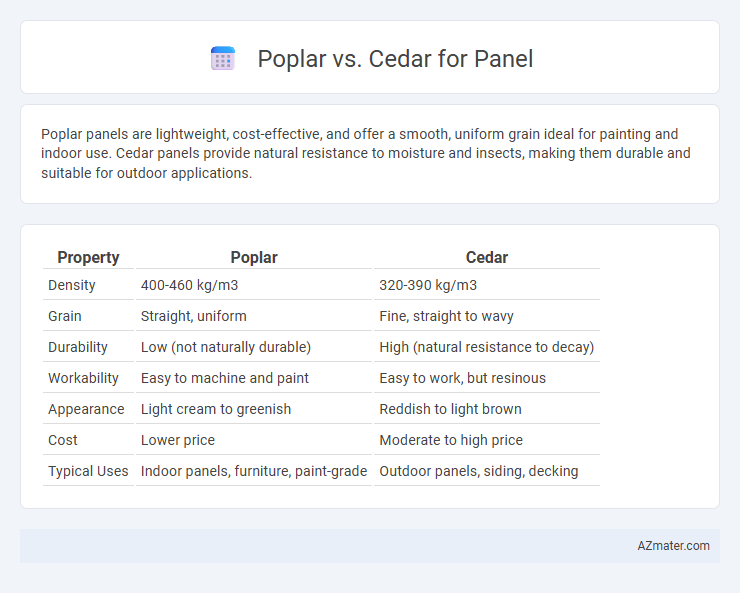Poplar panels are lightweight, cost-effective, and offer a smooth, uniform grain ideal for painting and indoor use. Cedar panels provide natural resistance to moisture and insects, making them durable and suitable for outdoor applications.
Table of Comparison
| Property | Poplar | Cedar |
|---|---|---|
| Density | 400-460 kg/m3 | 320-390 kg/m3 |
| Grain | Straight, uniform | Fine, straight to wavy |
| Durability | Low (not naturally durable) | High (natural resistance to decay) |
| Workability | Easy to machine and paint | Easy to work, but resinous |
| Appearance | Light cream to greenish | Reddish to light brown |
| Cost | Lower price | Moderate to high price |
| Typical Uses | Indoor panels, furniture, paint-grade | Outdoor panels, siding, decking |
Introduction to Poplar and Cedar for Panels
Poplar panels offer a lightweight, cost-effective option with a smooth grain ideal for painting and interior applications. Cedar panels provide natural resistance to decay and moisture, making them suitable for exterior uses and environments prone to humidity. Both woods present distinct advantages in durability and appearance, influencing their selection based on project requirements.
Key Characteristics of Poplar Wood
Poplar wood is valued for its light weight, straight grain, and smooth texture, making it an excellent choice for interior panels that require easy handling and finishing. It offers moderate hardness and dimensional stability, ensuring durability without excessive brittleness or warping. Poplar's pale creamy color and ability to accept paint and stains evenly enhance its versatility in decorative panel applications.
Key Characteristics of Cedar Wood
Cedar wood is prized for its natural resistance to decay and insect damage, making it an ideal choice for paneling in humid or outdoor environments. Its distinctive reddish hue and aromatic scent add aesthetic appeal and contribute to a pleasant indoor atmosphere. Cedar's lightweight yet durable structure, combined with excellent thermal insulation properties, offers long-lasting performance compared to Poplar panels.
Appearance and Grain Comparison
Poplar panels typically exhibit a light, creamy color with subtle greenish or brownish streaks, offering a smooth and consistent grain pattern that enhances a clean, modern look. Cedar panels showcase rich reddish-brown hues with prominent knots and a more pronounced, straight grain, creating a warm and rustic aesthetic ideal for decorative woodwork. The fine, even texture of poplar contrasts with cedar's pronounced aromatic oils and natural resistance to decay, making appearance and grain the primary factors when choosing between the two for interior paneling.
Durability and Resistance to Elements
Poplar wood offers moderate durability with low natural resistance to moisture and insects, making it less ideal for exterior paneling exposed to harsh weather conditions. Cedar boasts superior durability due to its natural oils that provide excellent resistance to rot, decay, and insect damage, ensuring longer lifespan in outdoor environments. Choosing cedar panels enhances protection against elements like humidity and UV exposure, whereas poplar requires additional treatment to achieve similar resilience.
Workability and Ease of Use
Poplar offers exceptional workability due to its fine, even grain and softness, allowing for effortless cutting, sanding, and shaping, making it ideal for intricate panel designs. Cedar, while slightly softer and more aromatic, poses challenges with resin pockets and a tendency to splinter, which can affect smooth finishes and require more careful handling during machining. The ease of use in poplar panels often results in faster project completion with less tool wear, whereas cedar demands more precision and maintenance, especially in power tool applications.
Cost and Availability Differences
Poplar panels are generally more affordable than cedar due to the faster growth rate and wider availability of poplar trees in North America. Cedar panels, known for their natural resistance to decay and insects, tend to have a higher price point influenced by limited supply and slower growth cycles. Availability of poplar is more consistent year-round, whereas cedar can experience seasonal fluctuations depending on local logging regulations and demand.
Environmental Impact and Sustainability
Poplar panels offer a lower environmental impact due to faster growth rates and higher carbon sequestration compared to cedar, making them a more sustainable choice for timber products. Cedar, while slower-growing, provides natural resistance to decay and pests without needing chemical treatments, contributing to longer panel lifespan and reducing replacement frequency. Sustainable forestry certifications for both species ensure responsible harvesting, but poplar's rapid renewability generally results in a smaller carbon footprint over the product lifecycle.
Best Applications for Poplar Panels
Poplar panels are ideal for interior applications such as furniture, cabinetry, and decorative moldings due to their fine, even texture and smooth finish. Their lightweight yet stable structure makes them suitable for paint-ready surfaces, offering excellent adherence and vibrant color results. Poplar also excels in crafting intricate designs and carving details, making it a preferred choice for detailed woodworking projects.
Best Applications for Cedar Panels
Cedar panels are highly valued for their natural resistance to moisture, decay, and insect damage, making them ideal for exterior siding, fencing, and outdoor structures. Their aromatic properties and attractive grain also enhance indoor applications such as closets and saunas where durability and scent are beneficial. Compared to Poplar, Cedar offers superior weather resistance and longevity, especially in environments exposed to harsh weather conditions.

Infographic: Poplar vs Cedar for Panel
 azmater.com
azmater.com